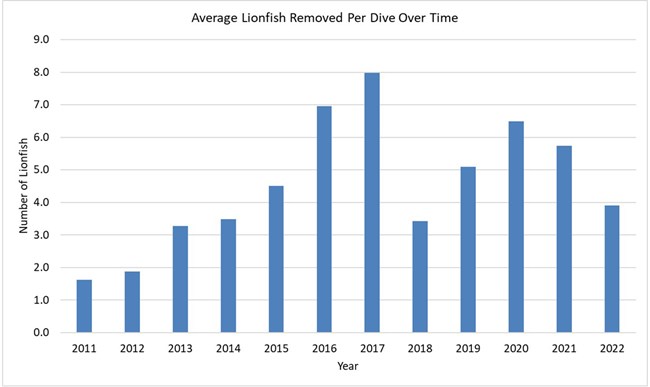Part of a series of articles titled Resource Management Efforts in Biscayne.
Article
Lionfish in Biscayne National Park

NPS Photo
Background
-
Indo-Pacific Lionfish (Pterois volitans and P. miles) the first exotic marine fish to be considered “invasive” in the Atlantic Ocean.
-
They are native to the Indian and Pacific Oceans and the Red Sea and were likely introduced to the Atlantic via the ornamental fish trade/aquarium releases and/or ballast water exchange.

NPS Photo
Threats
-
Lionfish are voracious, opportunistic predators that feed upon marine fish and invertebrates. Gut content analyses indicate that smaller lionfish feed on invertebrates (primarily shrimp) while larger lionfish eat mostly fish.
-
Lionfish have become successful invaders due to their broad diet, high physical tolerances, lack of natural predators, rapid growth rates, large native range, long life span, early sexual maturity, high fecundity and ability to reproduce year-round.
-
DNA barcoding of lionfish gut contents revealed the occurrence of six species of fish not previously known to occur in the park!
-
In conjunction with habitat degradation and over-fishing of native species, lionfish are negatively affecting native reef fish populations, reef ecosystems, and reef structure.
-
Lionfish possess venomous spines, making them a potential danger to people. A puncture from a venomous spine can cause intense pain, burning, swelling, redness, bleeding, joint pain, anxiety, headache, disorientation, dizziness, nausea, paralysis, and convulsions; however, no fatalities have been reported.

NPS Graph
Management Efforts at Biscayne
-
Since the first documented sighting in 2009, park biologists have conducted lionfish removals via SCUBA using pole spears and hand nets.
-
Each year, Park divers spend an average of 235 hours underwater over the course of more than 200 dives removing lionfish
-
Park scientists have collaborated with federal and state agencies as well as universities to complete studies to better understand and manage the lionfish invasion and it impacts to park resources.

NPS Graph
Outcomes
-
To date, park staff have removed more than 12,000 lionfish from park and immediately adjacent waters.
-
While lionfish have been observed across all marine habitats and depths, they are most abundant on deeper reefs and artificial habitats.
-
Removed lionfish average ~25 cm (9.8 inches) in length. The smallest removed lionfish was 3.2cm (1.3 inches) and the largest was 44.4cm (17.5 inches.
-
Lionfish harvest rates (number of fish per dive) grew steadily for several years and peaked in 2017.
-
After the passing Hurricane Irma (September of 2017), park divers observed a dramatic reduction in lionfish numbers and a slight increase in the average size of lionfish.
-
There are an estimated 250,000 lionfish in the park.

NPS Graph
Visitor and Community Outreach
-
Presentations and dissection events are offered at local schools, to visiting groups, and at special events.
-
Biscayne National Park staff guide school /students through lionfish dissections to demonstrate lionfish anatomy. Lionfish stomachs are emptied to determine what lionfish in Biscayne are eating.
-
Staff encourages spearfishers in the park to remove lionfish using safe removal and handling procedures.
Get involved/ What you can do to protect and preserve Biscayne National Park from lionfish
-
Report observations of lionfish “hotspots” to Park staff.
-
If you spearfish, remove lionfish when you see them.
-
Spread the word to others about the importance of reporting and removing lionfish.
Last updated: September 5, 2023
